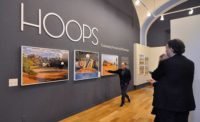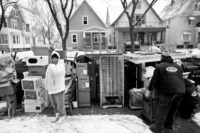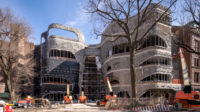Hive, the latest installment of Washington, D.C.’s National Building Museum’s Summer Block Party installation series, opens Thursday. Designed by Studio Gang Architects—the Chicago and New York-based firm founded by Jeanne Gang—Hive breaks down the vast scale of the museum’s neoclassical Great Hall into three more intimate, oculus-topped chambers made of stacked silver-and-magenta wound paper tubes.
Gang and her team drew much of the inspiration for Hive out of ideas relating to the occasionally problematic acoustics of the Great Hall: “The thing that we noticed when we first came into the Great Hall back in 2004 [for Gang’s installation, Marble Curtain], was that it feels like you’re outside in the middle of a big field, an expansive space, because there’s nothing for the sound to reflect off of,” Gang said at a press preview Monday. “We wanted to create spaces…where the acoustic properties would be noticeably different. By utilizing this catenary shape, each chamber balances the structural forces and supports its own weight while attaining height that enables a unique acoustic signature. The whole structure acts like a clearing in a forest, rather than a field.”
Though still under construction during the press preview, Hive’s chambers will reach a final height of 56.5 feet when completed, which will make it the tallest structure ever built inside the museum. The paper tubes that comprise the structures range in height from five inches to 10 feet, with diameters of six inches to two feet, for an overall catalog of 2,551 paper tubes in nine different tube sizes. The tubes, which are often used as formwork for cylindrical concrete columns, are oriented vertically, and notched to form interlocking rings that taper before culminating in circular openings, framing views up to the museum’s ceiling.
While Gang noted that the first model of the structure was an analog one, made with humble toilet paper tubes, she and her team quickly moved into the digital realm, eventually realizing a 1:1 digital model that included each tube of the built structure. “We do a lot of digital modeling and testing, “ Gang said. “If you can make an analog physical model, it’s really helpful as a tool for your own understanding, but it’s also a great communication tool with others who might not be able to read plans, sections, and 3D models—and it’s fun.”
Additional fun-making mechanisms occupy the two smaller chambers, which include musical instruments: A tubulum—an instrument made from commonplace plumbing materials—is the centerpiece of one; chimes made from items found within the museum encircle the other. Within the chambers, programmable LED luminaires fitted within small-diameter paper tubes act like integrated can lights for direct illumination. Daylight within the Great Hall filters through the tubes to provide a general ambient glow that changes throughout the course of the day. The central chamber will serve as a gathering place for both scheduled and impromptu events. Programming for the space includes yoga instruction, a dance party, and several after-hours cocktail hours with barbecue from a local restaurant.
Hive is the fourth Summer Block Party installation at the National Building Museum, and follows on the successes of The BIG Maze, by Bjarke Ingels Group, in 2014; The Beach, by Snarkitecture, in 2015; and Icebergs, by James Corner Field Operations, last year.
Hive will be on view at the National Building Museum through September 4, 2017.
Courtesy of Work Zone Cam























Post a comment to this article
Report Abusive Comment